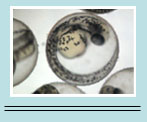

Home
Common Techniques
Classroom Experiments
Virtual Experiments
Tutorials
Games
Glossary
Links
Publishing
Opportunities
About This Site
Contact Us
ZFIN
Cite Us
Developmental Staging Experiment
Zebrafish develop at a rapid pace. After just 24 hours, the one cell form develops into a vertebrate embryo. First, the embryo is at the one cell stage and the cytoplasm moves to the animal pole, forming the blastodisc. The top layer divides, forming a two cell embryo. These first two states are in the zygote period.
Next, the embryo undergoes six cleavages where the cells (or blastomeres) divide synchronously every fifteen minutes. At each division the number of cells at the animal pole of the embryo doubles. This is known as the cleavage stage.
At 128 cell stage, the embryo enters the blastula stage. There is mound ball of cells apparent at the animal pole of the embryo. The mid-blastula stage brings on the formation of the yolk syncytial layer, which consists of vegetal cells of the blastoderm fused with the yolk cell. Gene transcription and cell movement begins. Cells begin to cover the yolk sac.
At the gastrula period, epiboly occurs. The cells undergo various movements and there is 90% epiboly around the yolk sac.
Next at the segmentation period, somites form. In addition, the tail formation begins.
At the pharyngula period, the body axis straightens. It no longer curves around the yolk sac. The fins begin to develop.
At 72 hours, the fish hatches and enter the environment.